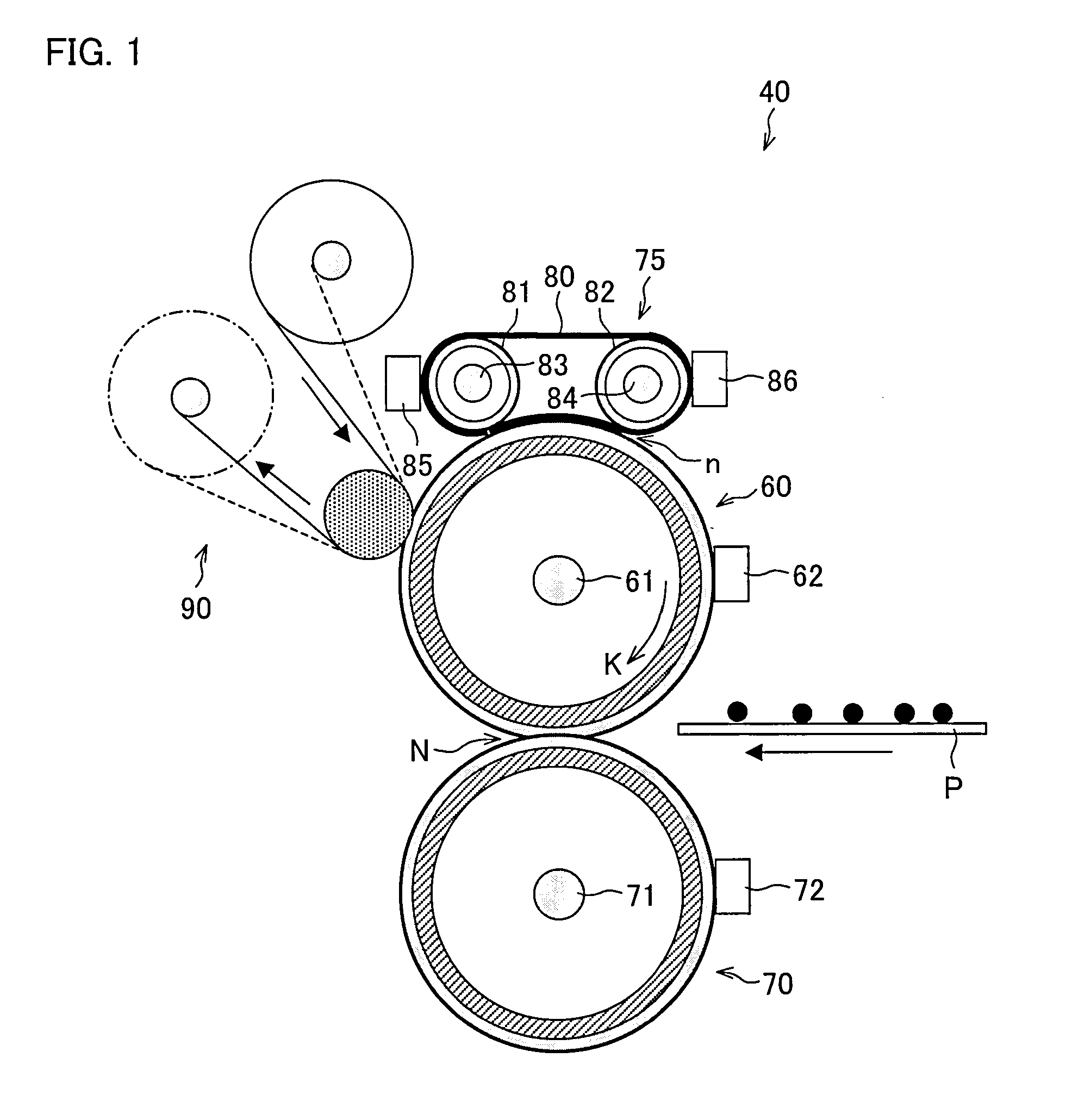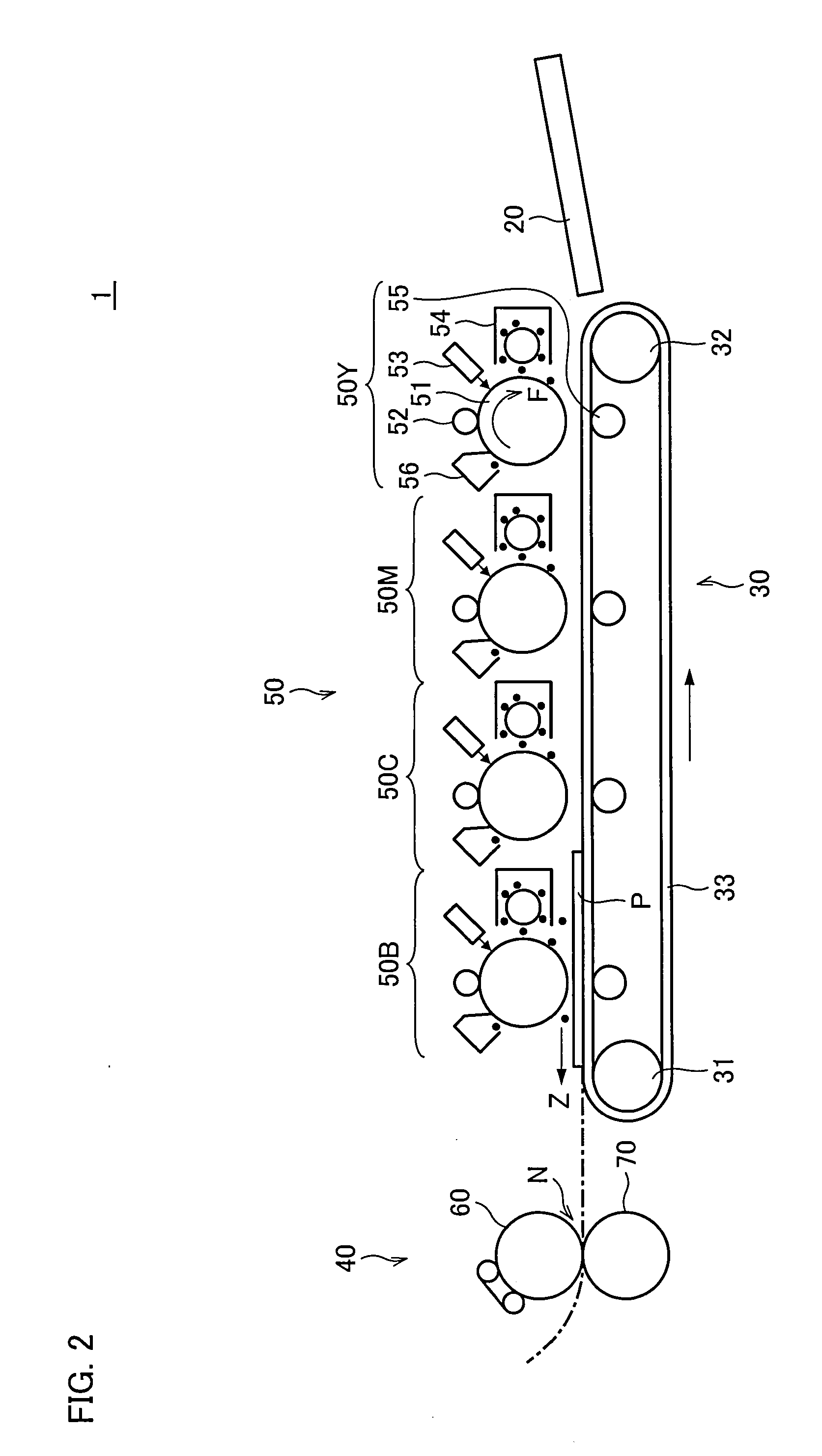Fixing apparatus and image forming apparatus provided therewith
a technology of fixing rollers and fixing rollers, which is applied in the direction of electrographic process apparatus, instruments, optics, etc., can solve the problems of long warm up time, inability to keep up with the surface temperature of the fixing roller, and poor heat transfer efficiency, and achieves quick release/contact operation in a small space and low power without encouraging deterioration of the belt member.
- Summary
- Abstract
- Description
- Claims
- Application Information
AI Technical Summary
Benefits of technology
Problems solved by technology
Method used
Image
Examples
first embodiment
[0041]The following will describe one embodiment of the present invention with reference to FIG. 1 through FIG. 5. First, referring to FIG. 2, description is made as to an image forming apparatus provided with a fixing apparatus according to one embodiment of the present invention. FIG. 2 is a diagram illustrating an internal structure of the image forming apparatus.
[0042]An image forming apparatus 1 shown in FIG. 2 forms a color image or a monochromatic image on paper (printing medium) P based on image data. In this embodiment, description will be made based on a four-tandem-engine color printer of a dry electrophotographic system. The image data is transmitted via a network or read out by a scanner.
[0043]The image forming apparatus 1 includes a visualized image forming section 50, a sheet transport section 30, a fixing apparatus 40, and a paper feed tray 20.
[0044]The visualized image forming section 50 includes an yellow visualized image forming unit SOY, a magenta visualized imag...
second embodiment
[0105]The following will describe another embodiment of the present invention with reference to FIG. 6 and FIG. 7. For convenience of explanation, constituting members having the same functions as those described in the First Embodiment are given the same reference numerals and explanations thereof are omitted here.
[0106]An image forming apparatus of the present embodiment differs from the image forming apparatus 1 of the First Embodiment only in the arrangement of the release / contact mechanism by which the heat rollers 81 and 82 are separated from or brought into contact with the surface of the fixing roller 60 in the fixing apparatus 40. As such, the following description deals with only the release / contact mechanism.
[0107]FIGS. 6(a) and 6(b) are diagrams illustrating a structure of a support section for the external heating section 75. FIG. 4 is an upper view of the support section. A release / contact mechanism 200 is provided in the support section.
[0108]The release / contact mecha...
third embodiment
[0110]The following will describe another embodiment of the present invention with reference to FIG. 8. Note that, constituting members having the same functions as those described in the foregoing First and Second Embodiments are given the same reference numerals and explanations thereof are omitted here.
[0111]An image forming apparatus of the present embodiment differs from the image forming apparatus 1 of the First Embodiment only in the arrangements of the external heating section and the release / contact mechanism in the fixing apparatus 40. As such, the following description only deals with the external heating section and the release / contact mechanism.
[0112]FIGS. 8(a) and 8(b) are diagrams illustrating a structure of a support section for an external heating section 76. A release / contact mechanism 300 is provided in the support section.
[0113]Instead of the heat roller 82, the external heating section 76 includes a support roller (pressing member) 87 that is not provided with t...
PUM
 Login to View More
Login to View More Abstract
Description
Claims
Application Information
 Login to View More
Login to View More - R&D
- Intellectual Property
- Life Sciences
- Materials
- Tech Scout
- Unparalleled Data Quality
- Higher Quality Content
- 60% Fewer Hallucinations
Browse by: Latest US Patents, China's latest patents, Technical Efficacy Thesaurus, Application Domain, Technology Topic, Popular Technical Reports.
© 2025 PatSnap. All rights reserved.Legal|Privacy policy|Modern Slavery Act Transparency Statement|Sitemap|About US| Contact US: help@patsnap.com



